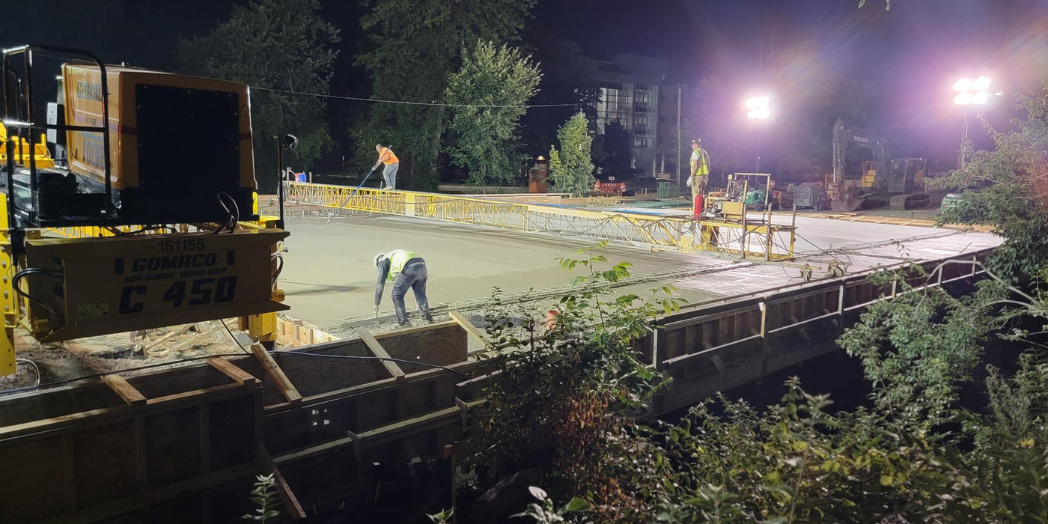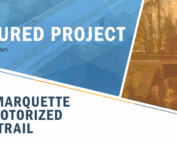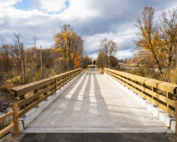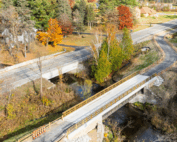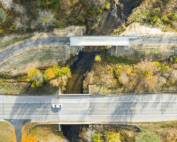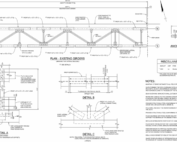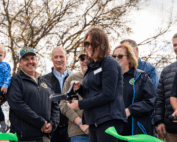Almost a century after it was first constructed to carry cars across the Red Cedar River, the Harrison Road Bridge in East Lansing is getting a much-needed rehabilitation. Located on Michigan State University’s campus, the project, led by the City of East Lansing, is on track to reopen by August 15, just in time for the start of the academic year. Clark Dietz was proud to support the project through roadway and bridge design, traffic control planning, and construction engineering and inspection.
Designing for the Future—Built on the Past

The project involves improvements to the bridge deck and approaches on Harrison Road over the Red Cedar River, between Harrison and Kalamazoo roads. Funded through MDOT’s LAP Bridge Program, the project modernizes a critical connection through the heart of Michigan State University’s campus. The design includes the removal and replacement of the bridge deck, barrier railing and approaches, beam repairs, structural steel replacement, riprap installation, backwall repairs, and wingwall replacement, including utility relocation and replacement. Furthermore, it includes five lanes—four travel lanes with a center turn lane—and sidewalks on both sides to ensure safe access for drivers, cyclists, and pedestrians.
Our team led the bridge and roadway design, including substructure protection using riprap to address scour and stabilize the area beneath the bridge. We also designed the approaches and developed a comprehensive work zone Maintenance of Traffic (MOT) plan to maintain mobility during construction.
To support traffic operations, we implemented temporary signal modifications at key intersections and coordinated new pavement markings. Right-of-way (ROW) coordination, utility planning, and construction inspection services were also part of our scope. Throughout the build, our team provided oversight of the road, bridge, and traffic elements—ensuring quality and regulatory compliance at every step.

Environmental compliance played a significant role in this project. In addition to NEPA-required bat surveys, the bridge’s crossing of the Red Cedar River triggered in-water regulatory requirements. Streamside Echo performed a freshwater mussel survey using snorkels and viewing scopes, identifying 35 live native mussels representing five species. Among them were the rainbow mussel and fluted-shell, both designated as species of special concern in Michigan. No threatened or endangered species were found, and all mussels were carefully returned to the river. These findings helped guide construction activity and protect sensitive aquatic habitats.
The bridge itself carries a layered history.
“When the bridge deck came off, you could see riveted steel beams from nearly a century ago—side by side with beams added during the 1990 expansion,” said Construction Project Manager Shawn Kraus, PE.
The stark difference in materials and design offered a rare look at the bridge’s evolution—and reinforced the need for a reconstruction to support today’s traffic and safety standards.

When Plans Change: Navigating the Unexpected
The Harrison Road Bridge reconstruction was originally designed as a staged, part-width construction project. The goal: keep one lane open in each direction to minimize disruption in this busy corridor. But as work began, unexpected challenges beneath the surface forced a change of course.
While removing the sidewalk, the team discovered that Vault 121—a large steam vault owned by Michigan State University—had been structurally tied into the bridge deck. This vault, which heats nearby campus buildings, was never supposed to be connected to the bridge structure. Worse, it was failing. The lid was delaminating and collapsing inward, making reconstruction of the bridge approaches impossible until the vault was addressed.
At the same time, contractors encountered undocumented utilities that conflicted with planned gas line relocations. These discoveries led to a series of delays that made the staged construction approach unworkable.
“We turned around detour revisions and signal changes in less than 24 hours to keep the project moving,” said Traffic Engineer Brandon Hasso, PE.
The Clark Dietz team provided same-day updates to detour plans, ensuring construction could proceed with minimal additional disruption.
Despite the obstacles, this shift proved essential to delivering the project on schedule. The ability to pivot quickly, revise traffic plans, and coordinate with multiple stakeholders demonstrated the strength of the team and the resilience of the design.
A Meaningful Project for Spartan Engineers
For many of our team members, it wasn’t just a bridge project—it was a chance to give back to the place that helped launch their careers.
For many on the Clark Dietz team, this project was more than just another job—it was a homecoming. Several of our engineers and designers who supported the Harrison Road Bridge reconstruction are proud alumni of Michigan State University. Being part of a project that improves safety and connectivity right on campus made the work deeply personal.
From detailed design to rapid response during construction, this effort brought together technical excellence and a shared sense of place. As students return and traffic resumes, the improved corridor will serve thousands of daily users—carrying forward both the legacy and future of this vital connection in East Lansing.
Clark Dietz is proud to partner with communities like East Lansing to deliver infrastructure that supports both safety and a sense of place. To learn more about our bridge and roadway services, or how we support municipal and university clients across the region, visit our Services page.
Project Managers: Pete Johnson, PE, (Design) (B.S.C.E. and M.S.C.E., Michigan State University, 1999, 2002) and Shawn Kraus, PE, (Construction) (B.S.C.E, Michigan State University, 1998)






